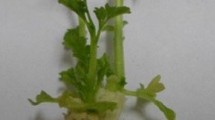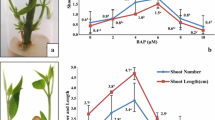Abstract
The objectives of our studies were to investigate the effect of cold pre-treatment duration and the effect of two different culture media (YP and N6) on maize anther culture response in two maize genotypes (A 18 and A 19) and to identify the gametic origin of the maize regenerants. Androgenic induction and callus formation was compared in anther cultures following pre-treatment applied to both media tested and with both maize genotypes. Higher plant regeneration was observed in case of YP media independently of the genotype used. The best results were achieved when 12 days (genotype A 18) or 14 days (in case of genotype A 19) cold pre-treatment at 10°C was applied. We have tested the possibility of using enzyme isoform analyses to identify the microspore origin of calli and plants derived from anther cultures. The 11 enzymes tested in our experiments were acid phosphatase, alcohol dehydrogenase, catalase, diaphorase, β-glucosidase, glutamate oxaloacetate transaminase, isocitrate dehydrogenase, malate dehydrogenase, 6-phosphogluconate dehydrogenase, phosphoglucomutase and phosphoglucoisomerase. Analysis of malate dehydrogenase proved the gametic origin of the calli initiated and of the DH plants regenerated from anther culture, when the coleoptile of the donor plant material showed two forms of enzyme 3/6 and the analysed calli showed only one of the two forms (3 or 6).
Similar content being viewed by others
References
Ambrus H, Darkó E, Szabó L, Bakos F, Király Z, Barnabás B (2006) In vitro microspore selection in maize anther culture with oxidative stress stimulators. Protoplasma 228:87–94
Aulinger IE, Peter SO, Schmid JE, Stamp P (2003) Rapid attainment of a doubled haploid line from transgenic maize (Zea mays L.) plants by means of anther culture. In Vitro Cell Dev Plant 39:165–170
Barloy D, Denis L, Beckert M (1989) Comparison of the aptitude for anther culture in some androgenic double haploid maize lines. Maydica 34:303–308
Barnabás B, Fransz PF, Schel JHN (1987) Ultrastructural studies on pollen embryogenesis in maize (Zea mays L.). Plant Cell Rep 6:212–215
Barnabás B, Obert B, Kovács G (1999) Colchicine, an efficient genome-doubling agent for maize (Zea mays L.) microspores cultured in anthero. Plant Cell Rep 18:858–862
Barnabás B, Pónya Z, Szakács É, Timár I, Obert B, Preťová A (2001) Biotechnology and micromanipulation of sexual processes in flowering plants. Biologia 56:7–12
Barnabás B (2003) Anther culture of maize (Zea mays L.). In: Maluszynski M, Kasha KJ, Forster BP, Szarejko I (eds) Doubled haploid production in crop plants a manual. Kluwer Academic Publishers, Dordrecht, p 428
Barret P, Brinkman M, Dufour P, Murigneux A, Beckert M (2004) Identification of candidate genes for in vitro androgenesis induction in maize. Theor Appl Genet 109:1660–1668
Bartošová Z, Obert B, Takáč T, Kormuťák A, Preťová A (2005) Using enzyme polymorphism to identify the gametic origin of flax regenerants. Acta Biol Cracov Bot 47:173–178
Bourgoin-Greneche M, Lallemand J (1993) Electrophoresis and its application to the description of varieties. A presentation of the techniques used by GEVES. GEVES, La Miniere, France, p 63
Bourgoin-Greneche M, Lallemand J, Pouget R (1998) Technical reference manual for the isoenzymatic analysis of maize. F 78285, GEVES, Guyancourt, France, p 73
Büter B, Pescitelli SM, Berger K, Schmid JE, Stamp P (1993) Autoclaved and filter sterilized liquid media in maize anther culture—significance of activated charcoal. Plant Cell Rep 13:79–82
Cardy BJ, Stuber CW, Goodman MM (1980) Techniques for starch gel electrophoresis of enzymes from maize (Zea mays L.). Institute of Statistics Mimeograph Series No. 1317, North Carolina State University, Raleigh, p 87
Coumans MP, Sohota S, Swanson EB (1989) Plant development from isolated microspores of Zea mays L. Plant Cell Rep 7:618–621
Čurn V (1995) Acid phosphatase and leucine aminopeptidase isozymes as biochemical markers of homogeneity in oil seed rape androgenetic lines. Plant Growth Regul 16:59–63
Chu CC (1981) The N6 medium and its applications to anther culture of cereal crops. In: Proc. sym. plant tissue culture, Beijing 1978, Pitman, Boston, pp 43–50
Dieu P, Beckert M (1986) Further studies of androgenic embryo production and plant regeneration from in vitro cultured anthers in maize (Zea mays L). Maydica 31:245–259
Elmaghrabi A, Ochatt S (2006) Isoenzymes and flow cytometry for the assessment of true-to-typeness of calluses and cell suspensions of barrel medic prior to regeneration. Plant Cell Tissue Organ 85:31–43
Forster BP, Thomas WTB (2004) Doubled haploids in genetics and plant breeding. Plant Breed Rev 25:57–88
Frova C (1990) Analysis of gene expression in microspores, pollen, and silks of Zea mays L. Sex Plant Reprod 3:200–206
Frova C, Binelli G, Ottaviano E (1987) Isozyme and HSP gene expression during male gametophyte development in maize. In: Isozymes: current topics in biological and medical research, vol 15: genetics, development, and evolution, pp 97–120
Genovesi AD, Collins GB (1982) In vitro production of haploid plants of corn via anther culture. Crop Sci 22:1137–1144
Gorla MS, Frova C, Binelli G, Ottaviano E (1986) The extent of gametophytic-sporophytic gene expression in maize. Theor Appl Genet 72:42–47
Greneche M, Giraud G (1989) Manuel technique de reference pour l’analyse isoenzymatique du Mais. GEVES, Surgeres, France, p 78
Jähne A, Lörz H (1995) Cereal microspore culture. Plant Sci 109:1–12
Jäger K, Kószegi DV, Barnabás B (2005) Regeneration capacity of microspore—derived structures produced in anther cultures of maize (Zea mays L.). Acta Physiol Plant 27:621–629
Ku MK, Cheng WC, You LC, Kuan HP, Huang CH (1978) Induction factors and morphocytological characteristic of pollen derived plants in maize (Zea mays L.). In: Proc. symp. plant tissue culture, 1978, Science Press, Peking, pp 35–45
Kuo CS, Sun AC, Wang YY, Gui YL, Gu SR, Miao SH (1978) Studies on induction of pollen plants and androgenesis in maize. Acta Bot Sin 20:204–209
Maraschin SF, de Priester W, Spaink HP, Wang M (2005) Androgenic switch: an example of plant embryogenesis from the male gametophyte perspective. J Exp Bot 56:1711–1726
Markert CL, Moller F (1959) Multiple forms of enzymes: tissues, cytogenic and species specific patterns. Proc Natl Acad Sci USA 45:753–763
Mejza SJ, Morgant V, DiBona DE, Wong JR (1993) Plant regeneration from isolated microspores of Triticum aestivum. Plant Cell Rep 12:149–153
Miao SH, Kuo CS, Kwei YL, Sun AT, Ku SY, Lu WL, Wang YY (1978) Introduction of pollen plants of maize and observation of their progeny. In: Proc. symp. plant tissue culture, 1978, Science Press, Peking, pp 23–24
Múdry P, Dragúň M (2005a) Above standard description and evaluation of local populations of maize (Zea mays L.). In: Proceedings of 4th seminar: evaluation of plant genetic resources, VÚRV, Piešťany, pp 175–176
Múdry P, Dragúň M (2005b) Proteomic classification of self-pollinated lines of maize (Zea mays L.) and their single crosses—reality and perspectives of utilization. In: New achievements of genetics and breeding in agricultural crops 12, VÚRV, Piešťany, 23.–24.11.2005
Múdry P, Juráček L’ (1998) Biochemical and genetic biodiversity of maize lines on the base of polymorphism of selected types of enzymes. In: Short communications volume II, fifth congress 28 June–2 July 1998, European Society for Agronomy, Nitra, The Slovac Republic, pp 279–280
Múdry P, Juráček L’ (2001) Modifikovaná štandardizovaná metodika analýzy polymorfizmu jedenástich druhov enzýmov—molekulárnych značkovačov kukurice siatej (Zea mays L.). In: Biotechnologické metódy v šľachtení rastlín BIOS 2001, Zborník referátov zo VII. Vedeckej konferencie s medzinárodnou účasťou, SPU, Nitra
Nageli M, Schmid JE, Stamp P, Büter B (1999) Improved formation of regenerable callus in isolated microspore culture of maize: impact of carbohydrates, plating density and time transfer. Plant Cell Rep 19:177–184
Obert B, Orosz A, Kovács G, Barnabás B (1998) Study of the androgenic capacity in crosses between highly androgenic exotic DH lines and recalcitrant commercial inbreeds in maize anther culture. Novenytermeles 47:473–481
Obert B, Preťová A, Büter B, Schmid JE (2000) Effect of different saccharides on viability of isolated microspores and androgenic induction in Zea mays. Biol Plant 43:125–128
Obert B, Barnabás B (2004) Colchicine induced embryogenesis in maize. Plant Cell Tissue Organ 77:283–285
Obert B, Szabó L, Mitykó J, Preťová A, Barnabás B (2005) Morphological events undergoing in cultures of mechanically isolated maize microspores. In Vitro Cell Dev Plant 41:775–782
Pescitelli SM, Johnson CD, Petolino JF (1990) Isolated microspore culture of maize: effect of isolation technique reduced temperature and sucrose level. Plant Cell Rep 8:628–631
Petolino JF, Jones AM (1986) Anther culture of elite genotypes of maize. Crop Sci 26:1072–1074
Petolino JF, Jones AM, Thompson SA (1988) Selection for increased anther culture response in maize. Theor Appl Genet 76:157–159
Preťová A, de Ruijter NCA, van Lammeren AAM, Schel JHN (1993) Structural observations during androgenic microspore culture of the 4c1 genotype of Zea mays L. Euphytica 65:61–69
Preťová A, Obert B, Bartošová Z (2006) Haploid formation in maize, barley, flax and potato. Protoplasma 228:107–114
Redha A, Islam SMS, Büter B, Stamp P, Schmid JE (2000) The improvement in regenerated doubled haploids from anther culture of wheat by anther transfer. Plant Cell Tissue Organ 63:167–172
Shariatpanahi ME, Bal U, Heberle-Bors E, Touraev A (2006) Stresses applied for the re-programming of plant microspores towards in vitro embryogenesis. Physiol Plant 127:519–534
Shim YS, Kasha KJ, Simion E, Letarte J (2006) The relationship between induction of embryogenesis and chromosome doubling in microspore cultures. Protoplasma 228:79–86
Stuber CW, Wendler JF, Goodman MN, Smith JSC (1988) Techniques and scoring procedures for starch gel electrophoresis of enzymes from maize (Zea mays L.). Technical Bulletin 286, North Carolina Agricultural Research Service, North Carolina State University, Raleigh, pp 1–87
Testillano PS, Georgiev S, Mogensen HL, Coronado MJ, Dumas C, Risueno MC, Matthys-Rochon E, Ting YC, Margaret YU, Wan Z (2004) Spontaneous chromosome doubling results from nuclear fusion during in vitro maize induced microspore embryogenesis. Chromosoma 112:342–349
Ting YC, Yu M, Zheng WZ (1981) Improved anther culture of maize (Zea mays). Plant Sci Lett 23:139–145
Touraev A, Vicente O, Heberle-Bors E (1997) Initiation of microspore embryogenesis by stress. Trends Plant Sci 2:297–302
Tsay HS, Miao SH, Widholm JM (1986) Factors affecting haploid plant regeneration from maize anther culture. J Plant Physiol 126:33–40
Wang M, Hoekstra S, Van Bergen S, Lamers GEM, Oppedijk BJ, Van der Heiden MW, De Priester W, Shilperoort RA (1999) Apoptosis in developing anthers and the role of ABA in this process during androgenesis in Hordeum vulgare L. Plant Mol Biol 39:489–501
Wang M, Van Bergen S, Van Duijn B (2000) Insight into a key developmental switch and its importance for efficient plant breeding. Plant Physiol 124:523–530
Acknowledgments
This work was supported by grant APVT-51-002302 and VEGA 2/5079/5. We would like to thank Professor Beáta Barnabás for providing seeds of maize genotypes used in our studies. B. O. is grateful to Alexander von Humboldt Foundation (Bonn, Germany) for his research fellowship.
Author information
Authors and Affiliations
Corresponding author
Additional information
Communicated by E. Lojkowska.
Rights and permissions
About this article
Cite this article
Uváčková, Ľ., Múdry, P., Obert, B. et al. Enzyme fingerprint analyses in tissue regenerated from anther culture of maize. Acta Physiol Plant 30, 779–785 (2008). https://doi.org/10.1007/s11738-008-0180-4
Received:
Revised:
Accepted:
Published:
Issue Date:
DOI: https://doi.org/10.1007/s11738-008-0180-4




